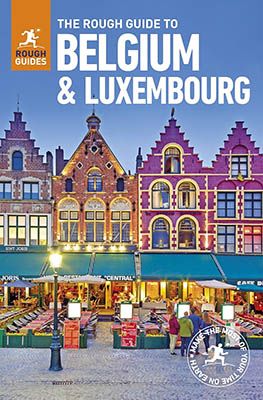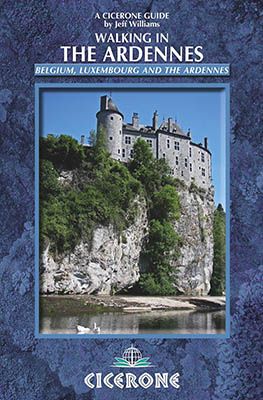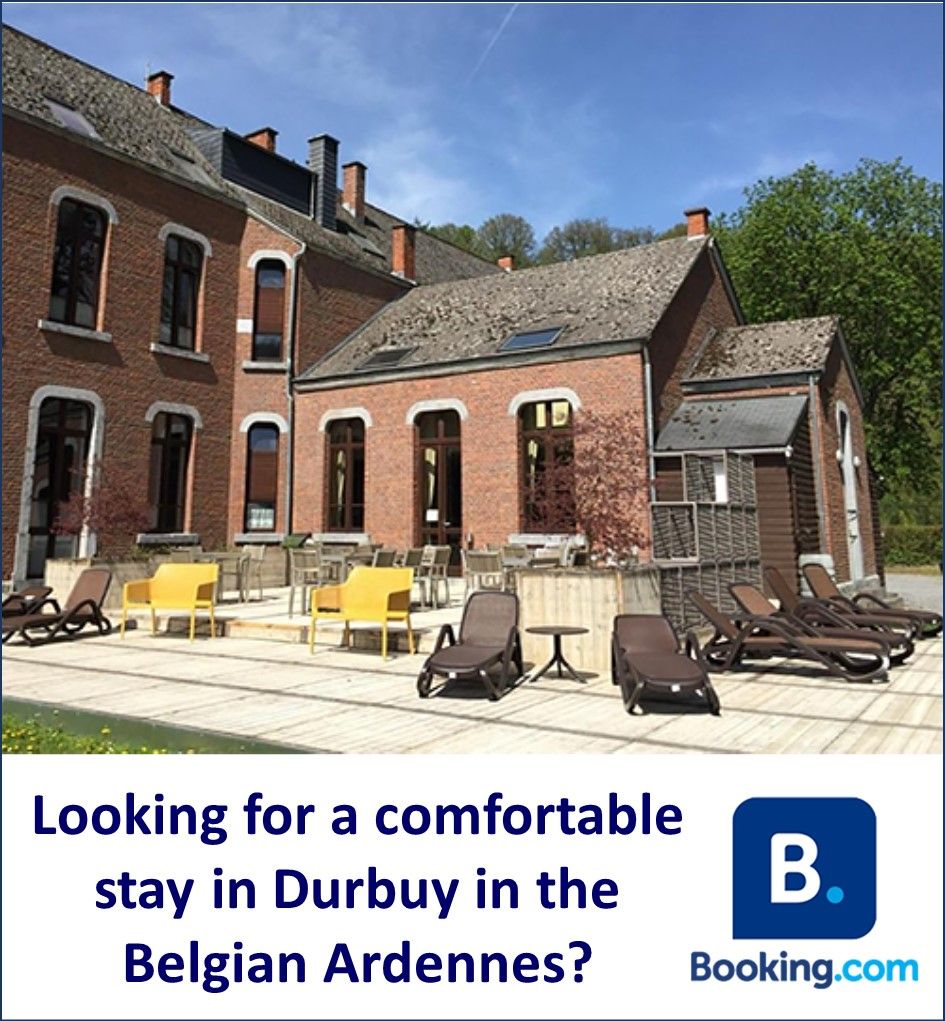Durbuy had been on our wish list for a while. We wanted to see the smallest city in the world with our own eyes. This cozy medieval city has been attracting many tourists for years. What is the allure of Durbuy? A major draw is the variety of local culinary specialties. And the best way to discover them is with a culinary walk through Durbuy. Guided by a local expert, we learn a lot about the city’s history, its main attractions, and of course, the many delicacies from the region. It was a surprising journey with many highlights. Will you walk with us?
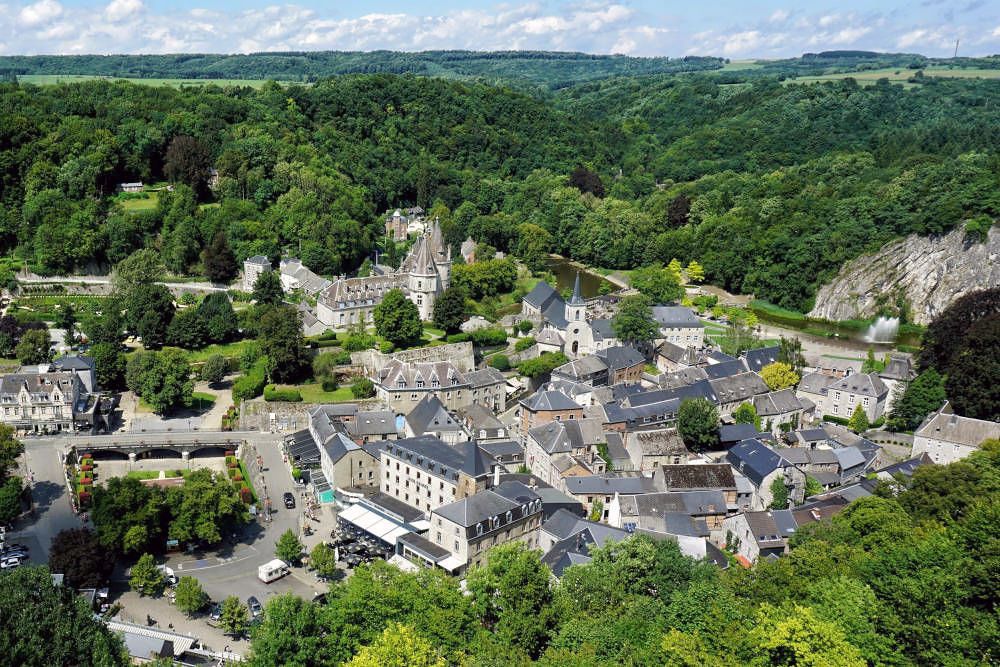
Culinary Walk through Durbuy
We are in luck as we spend a weekend in Durbuy. The weather is beautiful, and these days the Rallye de Durbuy is taking place. This three-day event with classic cars attracts many participants from both within and outside the country. Nearly every spot in the large car park is taken by a vintage sports car. Each one is more beautiful than the other. Many tourists are captivated by all these shiny cars. Especially the youth can’t get enough of the vehicles. Of course, we can’t resist the temptation either and take some photos of various classic cars.
Our goal is not merely a car ride in the surroundings of Durbuy. We want to get to know the medieval town with its many narrow cobblestone streets, numerous attractions, and culinary specialties. And how better to discover a city than with a local guide? This way, we hear the most extraordinary stories while enjoying the local delicacies. Time for the culinary walk through Durbuy!
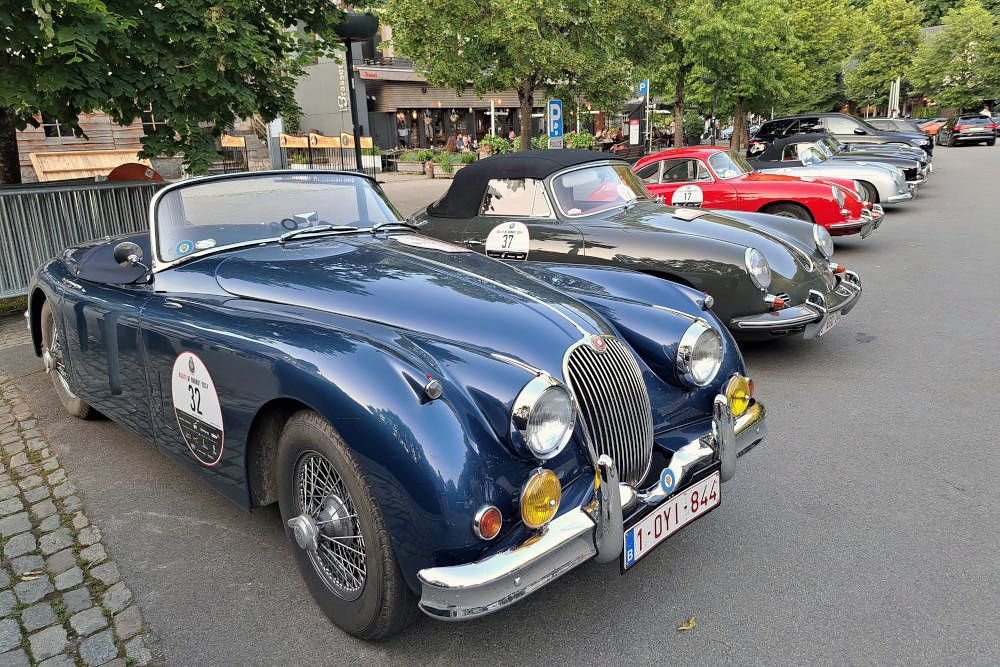
Our Guide for the Culinary Walk through Durbuy
Our guide Pierre welcomes us in the square in front of the tourist office. He is an energetic man, full of stories and humor, we quickly notice. With his straw hat, he looks quite characteristic. Over the next two hours, he will lead us to the highlights of Durbuy and, of course, let us taste all the delicious offerings the city has.
Pierre briefly tells us about the history of Durbuy. In the early Middle Ages, Durbuy developed as a settlement due to its strategic location on the Ourthe River. Durbuy was granted city rights in 1331. This brought certain privileges, such as the right to self-government and the holding of markets. Due to its strategic location and economic significance, Durbuy was fortified with city walls and a castle. Because the city was squeezed between the Ourthe on one side and the large cliff on the other, Durbuy could not expand. This kept it a small town. Durbuy proudly claims the title of “smallest city in the world.” Whether that is justified remains a question. According to us, the Dutch towns of Bronkhorst and Sloten are even smaller. The Croatian town of Hum is said to be of miniature size as well. But it is certainly excellent marketing for Durbuy.
After a brief historical introduction, it’s time for the first treat. And what better way to start the day than with a refreshing beer? Cheers!
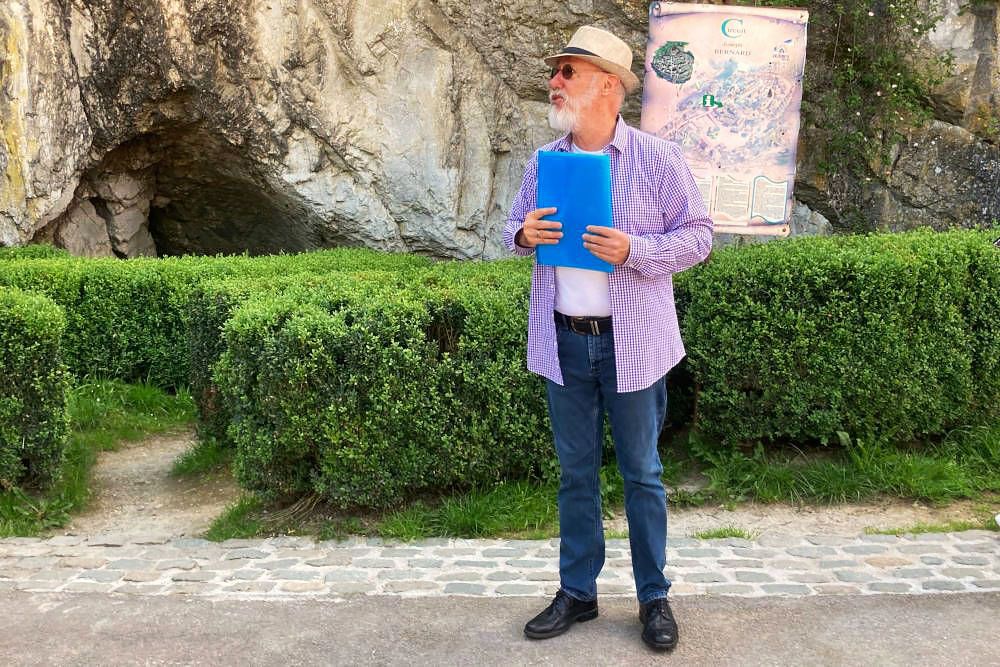
Sights on the Culinary Walk through Durbuy
It’s not just about tasting, eating, and drinking during the two hours. Guide Pierre takes us on a tour of the medieval center of Durbuy. The cobbled streets with old stone houses, historic buildings, and the cozy restaurants and shops give the city a special atmosphere.
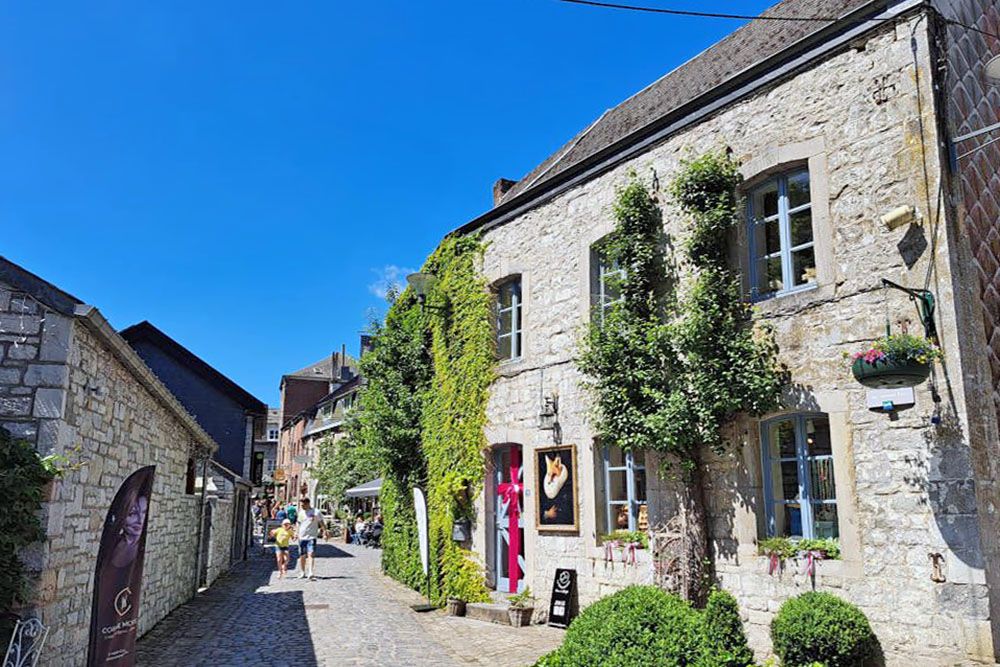
Grain Hall
The Grain Hall’s name doesn’t really cover what it is. From the 16th century, the public building has served many functions but has never been used as a grain storage. The timber framework at the front of the Grain Hall is remarkable, something that was not common in public buildings. The Grain Hall is one of the oldest buildings in Durbuy. It’s interesting that the Museum of Contemporary Art is now located here. The modern art forms a nice contrast with the old building.
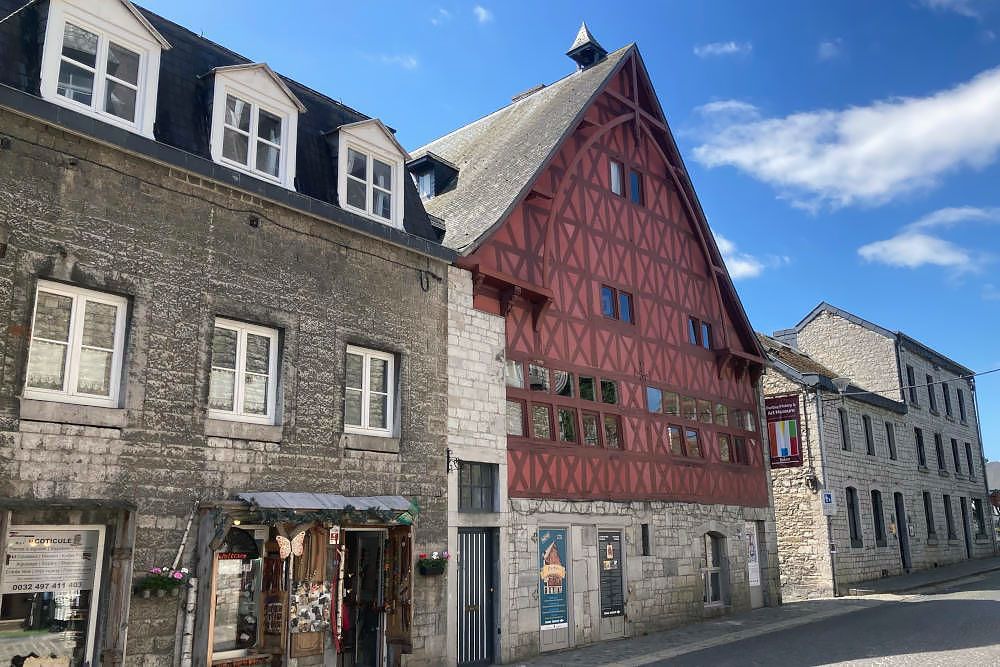
Saint Nicholas Church
The Saint Nicholas Church was built in 1630. The church is made of limestone. The nave has a Gothic style. The later added large choir has a much more classical style. The baroque pulpit is remarkable. Especially the decorations with various figures are impressive. The baptismal font from 1588, with a copper lid, is beautiful as well.
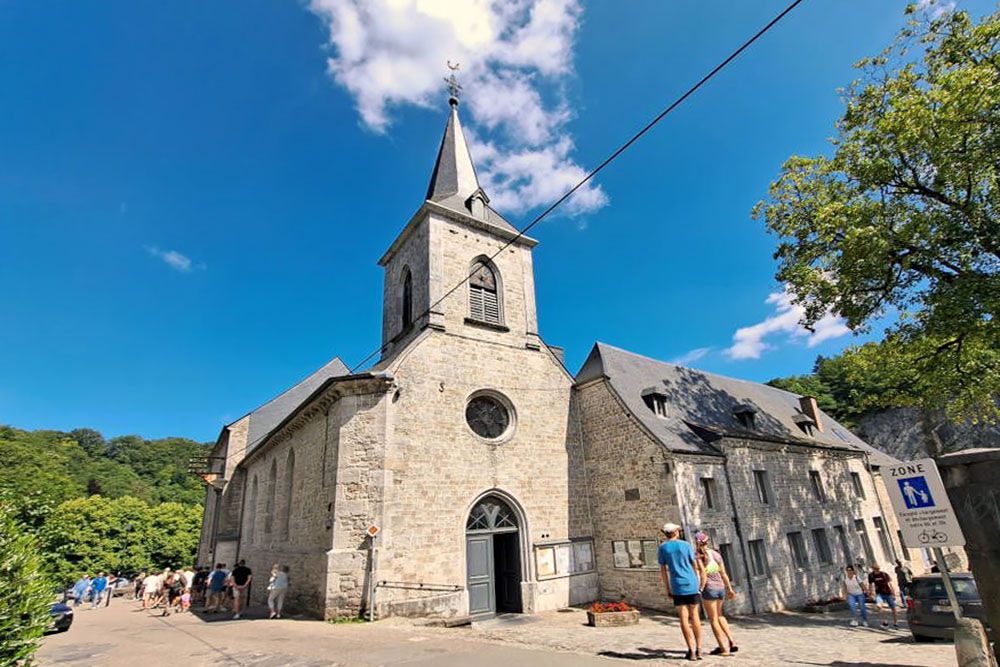
Durbuy Castle
In the eleventh century, Henry I of Namur, the Count of Durbuy, built a castle on the site where a fortress had stood before. The castle in its current form dates from the late 19th century. The castle is privately owned, so it cannot be visited. The ancient owner has no descendants. Perhaps it’s an idea to make friends with this lady?
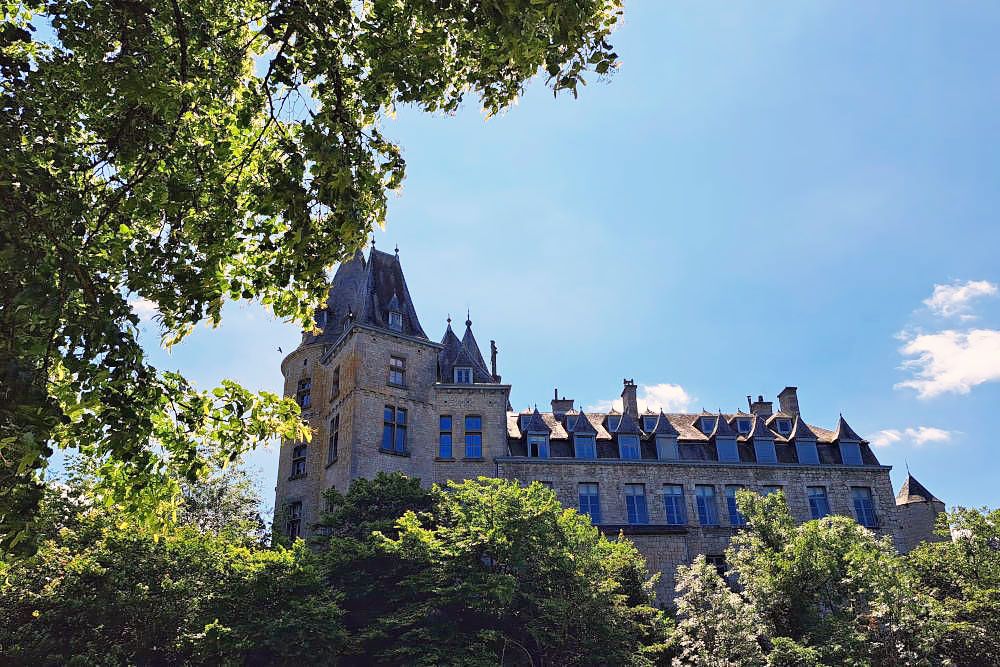
Monastery of the Récollets
The Order of the Récollets founded the monastery in the 17th century. The Récollets were known for their dedication to a life of poverty, humility, and prayer. Next to the monastery of the Récollets, the monastery of the Récollectines was later established. The Récollectines formed the female branch of the same order. The monastery complex is built in a simple style. It consists of various buildings, including a church, living quarters for the monks and nuns, and workshops.
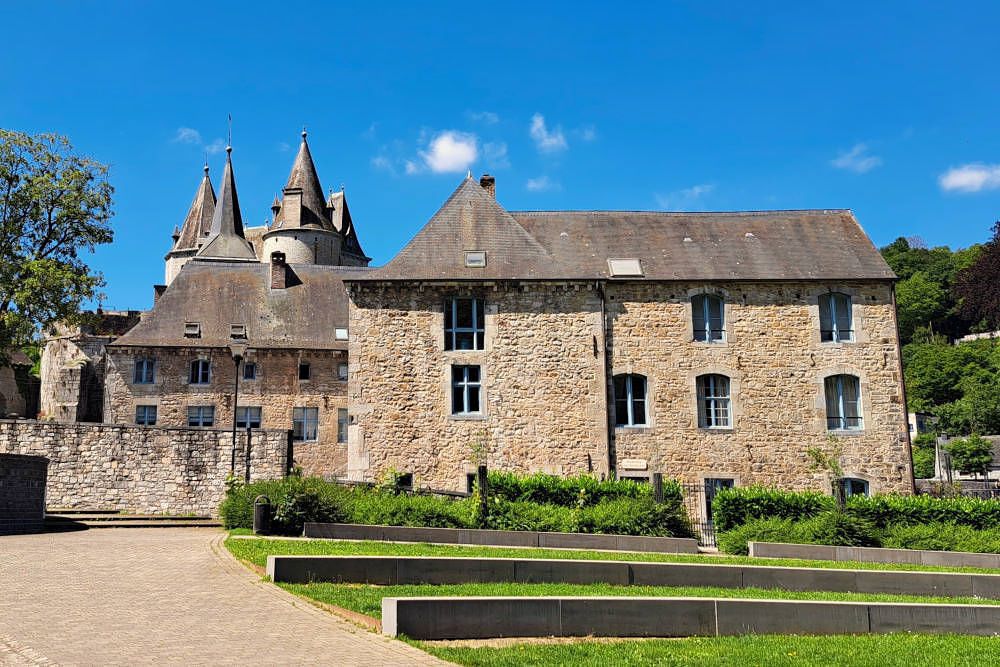
Homalius Rock
The medieval center of Durbuy is old, but the crown jewel is the rock at the back of the city. This Homalius rock is said to be about 300 million years old. If you look closely, you’ll notice the inverted U-shape of the rock. This was caused by different layers of limestone being pushed up over time. The rock is also called the “Falize Rock.”
From the benches in the square, we can admire the rock in all its glory. With the fountains in the foreground, it makes for a beautiful sight. It’s also worth turning around. Then we overlook the monastery of the Récollets.
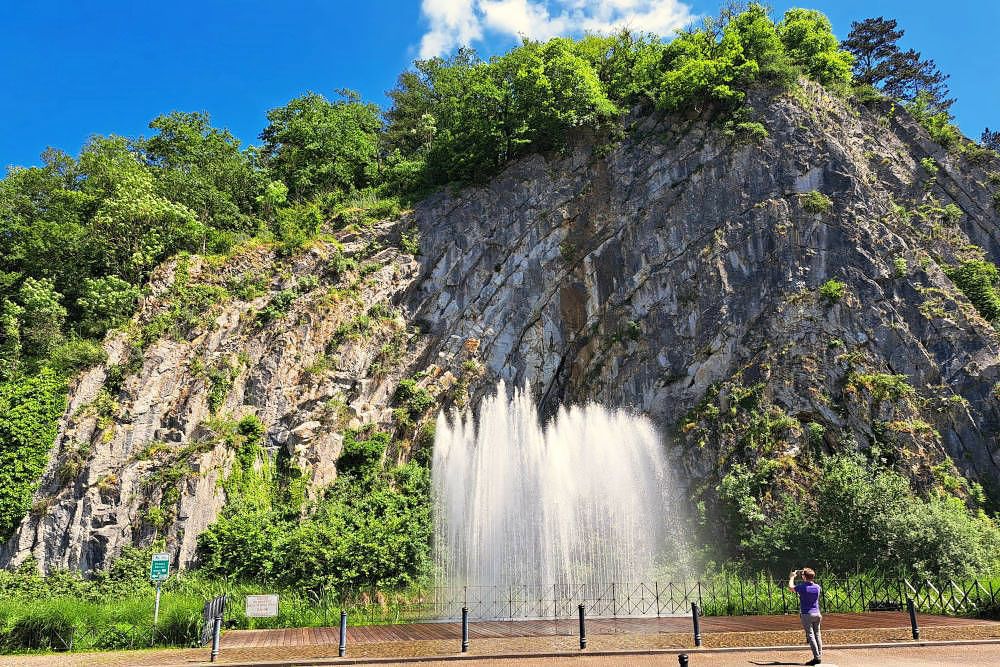
Topiary Art in Parc des Topiaires
Guide Pierre points out the entrance to Parc des Topiaires. The park contains beautiful gardens full of trimmed plants. The shapes are unique and creative. There are boxwoods in the shape of people, animals, and various abstract forms. The name “topiaries” has a Roman origin. It was the gardeners who trimmed plants, often in the shape of their employer’s initials. The art of topiary disappeared with the decline of the Roman Empire. In the Renaissance, this form of art came back into the spotlight.
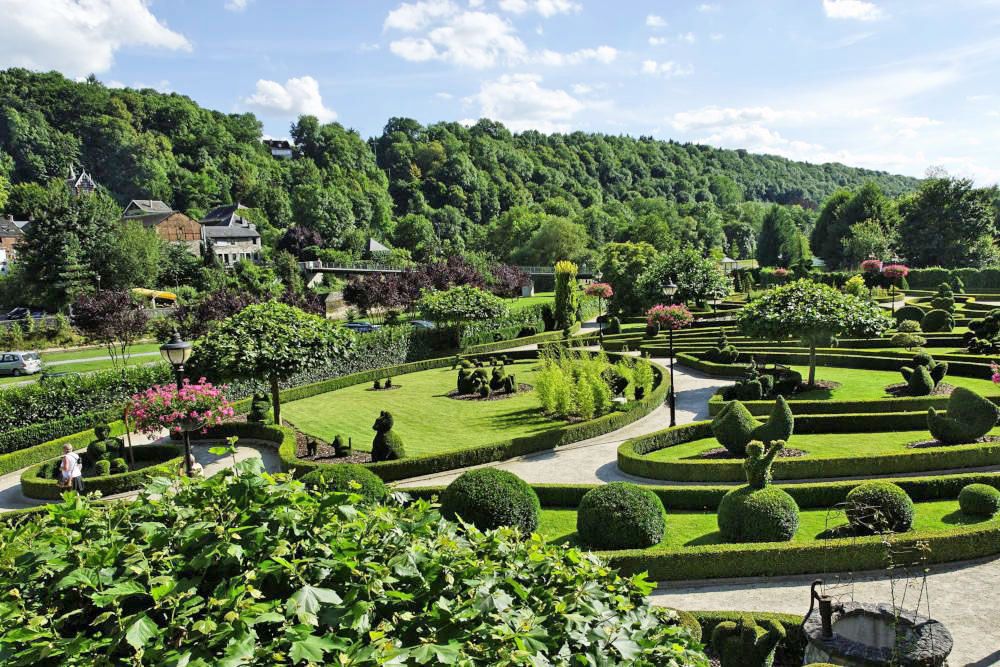
Tastings on the Culinary Walk through Durbuy
A culinary walk through Durbuy is only complete when we can taste the local specialties. Having already enjoyed the first beer, we savor many more tantalizing bites in these two hours. We sample special ice cream and savor a cracker with goat cheese, among other treats. Some delicacies are so unique that we spend extra time savoring them.
Chocolate Delight
In the authentic and photogenic sweet shop BonBon Chic, we find all kinds of sweets. Candy canes, lollipops, cookies, and of course, chocolates. We taste the “nose” of chocolate, or rather, a cuberdon. It looks like a little nose. Originally, the chocolate comes from Ghent, but it also tastes delicious in Durbuy. Hard on the outside, filled with a mixture of syrup and fruit aromas on the inside, delicious!
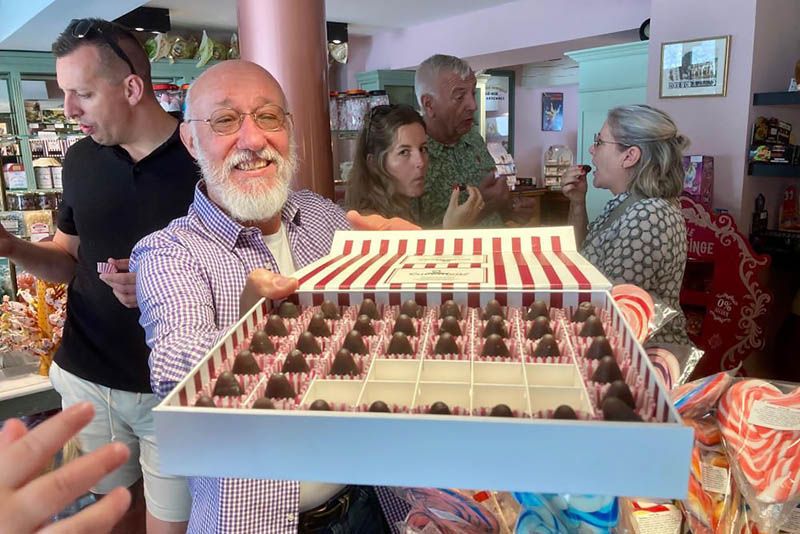
Unusual Jam
Saint Amour is a shop full of products that you would want to taste. Ideal for taking home a nice culinary souvenir. The specialty of Saint Amour is the unusual jams and preserves. All homemade, in a traditional way. Today, we taste a special preserve, served on a tasty cracker. We are asked to guess what we have tasted. All kinds of fruits come to mind, but we are completely off the mark. The preserve is made from dandelions!
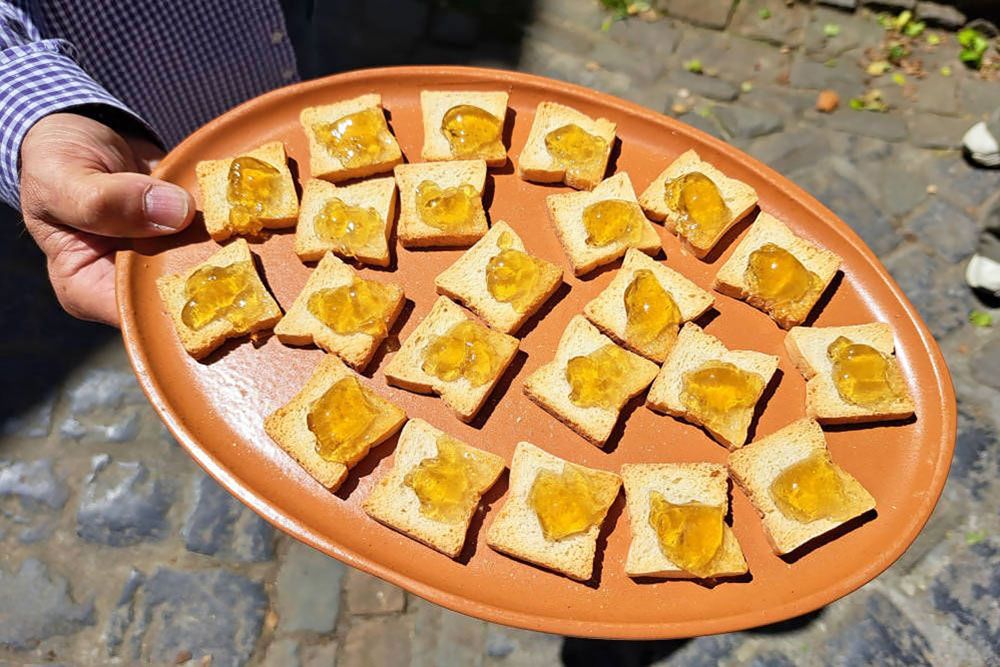
Ardennes Ham
The Ardennes is world-famous for its tasty hams. The best place to taste a special ham is at Boucherie Bodson & Fils. The traditional butcher attracts a lot of attention. Even a pig stands curiously on its hind legs, peeking into the shop window. The butcher shop is full of hams, salamis, and other types of sausages. We taste a piece of ham and a piece of salami. Deliciously spicy and intense in flavor.
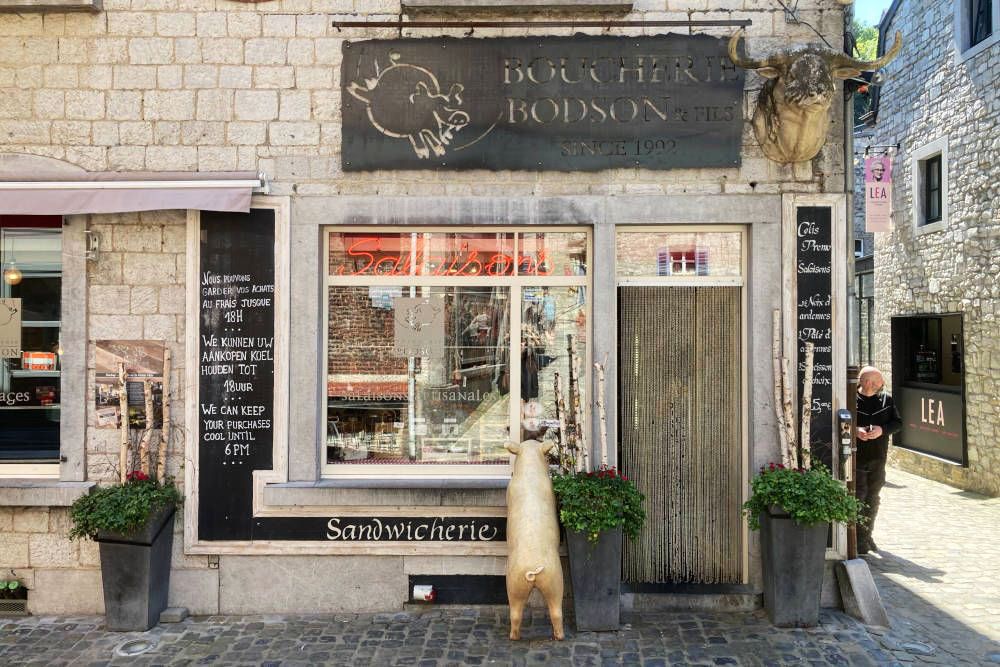
Ending with a Beer
The tour is over, and in just over two hours, guide Pierre has shown us the most beautiful spots. Along the way, we heard juicy anecdotes and got to know many of Durbuy’s attractions better. It was an experience to take part in this culinary walk through Durbuy, while enjoying various treats.
We end the morning in a fitting manner. Pierre pours us one last artisanal beer. Philippe Marckloff was a Russian brewer who settled in Durbuy in the 16th century. Marckloff Brewery has been producing exceptional beers in Durbuy for centuries. The amber beer tastes great, a worthy conclusion to a delightful culinary walk through Durbuy!
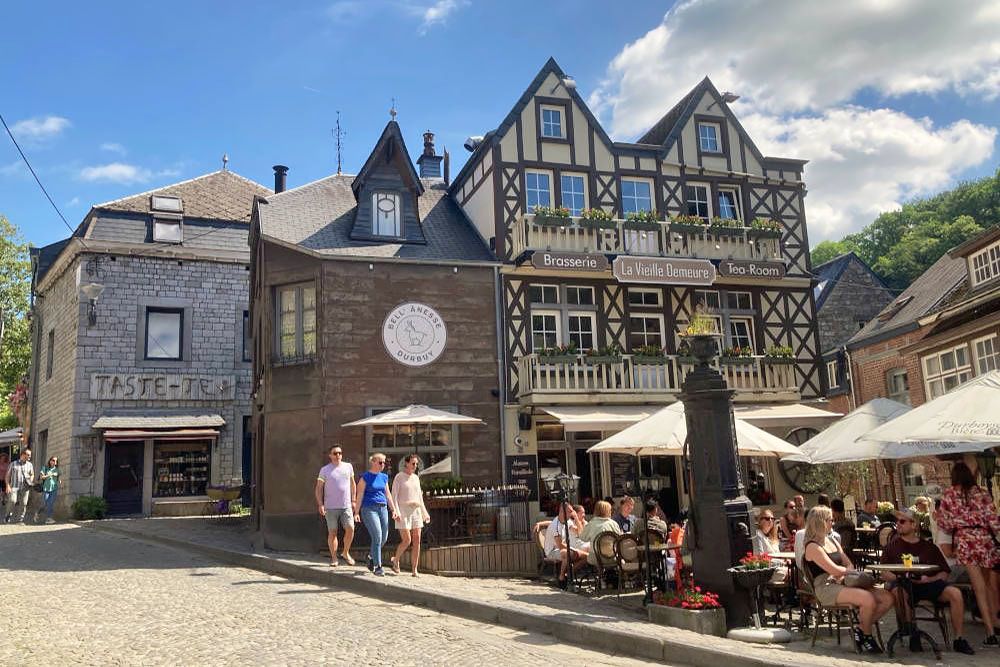
Things to Do and See in the Surroundings of Durbuy
The location in the Ardennes makes Durbuy an ideal place to further explore this region. You can take the most beautiful walks. Please let us know in the comments section at the bottom of this page if you are interested in our travel reports full of photos. If so, we will add them to this travel blog.
The region also has many cycling paths suitable for recreational cyclists. Routes take you through picturesque villages, along rivers and castles, and through forests. The landscape is hilly, with the occasional steep climb. For more relaxation, it’s nice to rent an e-bike. It’s much more comfortable to cycle through the hilly landscape on an e-bike. A beautiful cycle route is from Durbuy along the commemorative sites of the Battle of the Bulge.
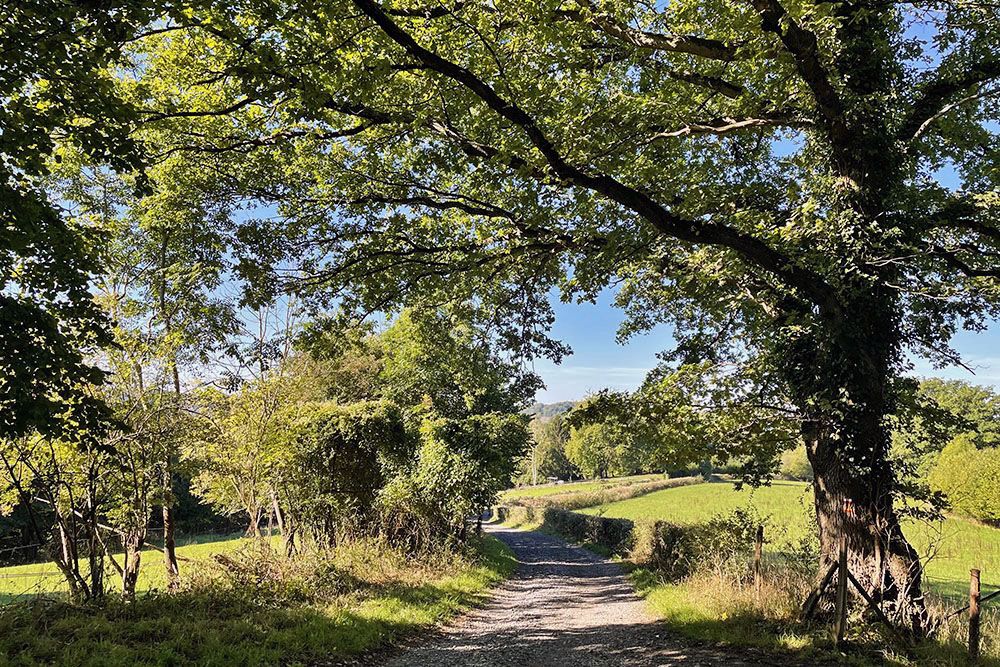
Canoeing or Kayaking on the Ourthe is a relaxing way to experience nature. The Ourthe not only flows past Durbuy, but also through places like Hotton, Barvaux, and La Roche-en Ardenne. The best time to do this is in the spring or autumn. Then the river has a good water level, and you may even encounter some rapids.
Cultural highlights
There are, of course, also cultural attractions:
- Less than half an hour from Durbuy is Château de Modave. It is a beautiful 17th-century castle. The interior is richly decorated, and the gardens are perfect for a peaceful walk.
- Another special castle is Radhadesh Castle. The castle used to belong to George Harrison. He donated it to the Hare Krishnas. In addition to tours, you can enjoy Eastern spirituality.
- Also not far away are the Hotton Caves. Less well-known than the Caves of Han, but just as beautiful!
- Finally, Wéris is a special place near Durbuy. A charming village that is among the most beautiful in Wallonia. The megalithic stones just outside the village are exceptional. Some of them look like dolmens. No one has an explanation for this phenomenon, but it’s beautiful nonetheless.
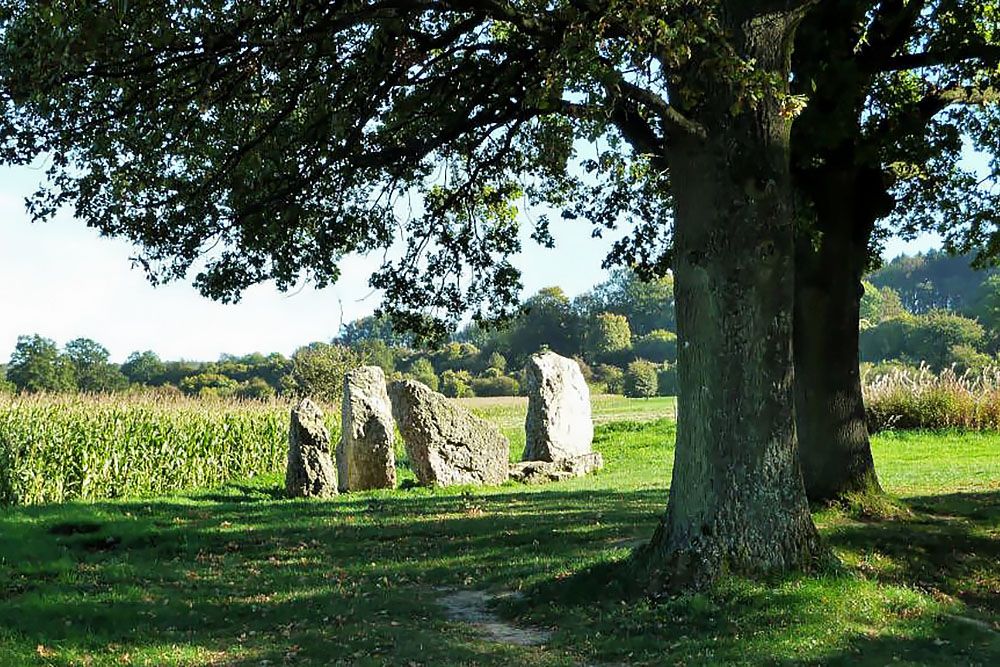
FAQs about the Culinary Walk Through Durbuy
Durbuy is situated in the province of Luxembourg, in the region of the Belgian Ardennes. It is located along the banks of the Ourthe River. Durbuy is approximately 90 kilometers southeast of Brussels and about 45 kilometers south of Liège.
By Car: From Brussels, take the E411 towards Namur. At Namur, take the exit towards the N4 towards Marche-en-Famenne. Follow the N4 and then take the N929 to Durbuy. The journey takes approximately 1.5 hours.
By Train and Bus: From Brussels, take the train to the Barvaux station, the nearest station to Durbuy. From Barvaux, you can take a local bus to Durbuy (line 11 of TEC). The total travel time is approximately 2.5 hours.
This city walk through Durbuy takes place every Saturday at 10:30 am and 1:30 pm. There is a Dutch-speaking guide available. Prior reservation is necessary and can be made via email to the Durbuy Tourist Office, by phone, or through a personal visit. The starting point is Place aux Foires, number 25 in Durbuy, opposite the Tourist Office.
The medieval center of Durbuy is essentially a large open-air museum. Strolling along the cobbled streets, you will discover beautiful buildings and monuments, such as the Museum of Contemporary Art housed in the beautiful Grain Hall, the St. Nicholas Church, the Durbuy Castle, and the Récollets Monastery. Particularly notable is the impressive rock on the edge of Durbuy, which is over 300 million years old. Garden enthusiasts will delight in Parc des Topiaires.
The region around Durbuy is perfect for a leisurely walk or an e-bike ride. You will pass by unique castles, charming places, and through a wooded area. The Ourthe River is ideal for a canoe trip. Additionally, you will find beautiful castles nearby, such as Chateau Modave or the Eastern-influenced Radhadesh Castle. The Caves of Hotton are less known than those of Han, but equally beautiful. Finally, the nearby village of Wéris is a pleasant place to explore. Don't forget to visit the unique megaliths just outside the village.
In the medieval center of Durbuy, you will find many restaurants, generally of good to very good quality. We had a tasty meal at La Canette, in a charming courtyard. The service could have been more attentive, but the food was still delicious. These are the best restaurants in Durbuy according to the ratings on TripAdvisor.
According to guests, these are the highest-rated hotels and bed & breakfasts in the center of Durbuy:
Hotels:
Bed & Breakfasts:
This is the full range of accommodation available in Durbuy.
We stayed 15 minutes away from Durbuy, in a wellness room at Mont des Pins. This brand new room had just been completed, and we were the first guests. We enjoyed our private sauna and the whirlpool bath. It was an excellent room with a few minor teething issues. Once those are resolved, this will be a top-notch stay.
Just 2 km from Durbuy is a bungalow park with cottages nestled in the woods. You will have a place full of privacy and stay in a beautiful environment.
We visited Durbuy at the invitation of Visit Wallonia. The content of this blog has been independently and objectively compiled based on our own impressions.

